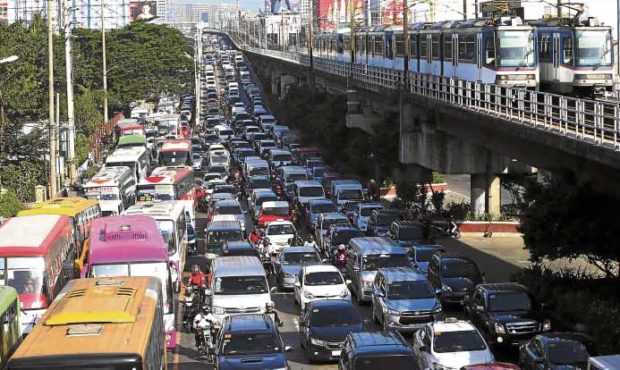Jica: Traffic congestion now costs P3.5 billion a day

Traffic gridlock along Edsa. INQUIRER file photo / EDWIN BACASMAS
The worsening traffic in Metro Manila now costs P3.5 billion in lost opportunities per day, highlighting the need for new and modern infrastructure to ease congestion, the Philippine office of the aid agency Japan International Cooperation Agency (Jica) said Thursday.
The updated figure for 2017 was presented by Jica Philippines chief representative Susumu Ito during the 36th Joint Meeting of the Japan-Philippines Economic Cooperation Committees in Makati City.
At P3.5 billion, it was higher than the estimated P2.4 billion in 2012, which was later included in the Mega Manila transport roadmap approved by the government in 2014.
“Metro Manila’s population in 2015 is almost 13 million people; Bulacan, Rizal, Laguna and Cavite [combined], almost 11 million. So Mega Manila [in 2015], 24 million people. But in 2025., Metro Manila’s [population would be] 16 million, and Mega manila including Bulacan, Laguna, Rizal and Cavite [would be] 38 million. So Mega Manila will be larger. It will be one of the largest cities in the world,” Ito said.
READ: Jica: Updated Mega Manila transport roadmap out in November
Article continues after this advertisementAs such, Ito said Metro Manila expected to be more congested, while the four surrounding provinces will also “see more rapid growth.”
Article continues after this advertisement“The traffic cost of P2.4 billion [five years ago] will swing to P3.5 billion a day in 2017,” Ito said, citing the latest preliminary estimates made by Jica.
In this regard, Ito said Jica and the Japanese government as a whole is “fully supportive” of the Duterte administration’s ambitious “Build, Build, Build” infrastructure program.
Under “Build, Build, Build,” the government plans to rollout 75 “game-changing” projects, with about half targeted to be finished within President Duterte’s term, alongside spending a total of over P8 trillion on hard and modern infrastructure until 2022 to usher in “the golden age of infrastructure” after years of neglect.
“The conclusion that we have is that ‘Build, Build, Build’ is a right direction. It’s a must do,” Ito said.
However, “even with ‘Build, Build, Build,’ bottlenecks will still remain in the outer area so additional projects should be implemented,” according to Ito.
“As you can see, the traffic cost is P3.5 billion a day in Metro Manila. If we do nothing, it will become P5.4 billion a day in 2035, but with ‘Build, Build, Build,’ it be reduced to P3 billion a day. With additional projects, it will be reduced to P2.4 billion a day,” Ito added.
Ito said the initial phase of the Metro Manila Subway Project is one of the initiatives that can ease traffic congestion in the metropolis.
Socioeconomic Planning Secretary Ernesto M. Pernia said during the meeting that the groundbreaking for the subway project was eyed in the third quarter of this year instead of early next year under an earlier plan.
Poised to be country’s first subway, the project is a 25.3-kilometer underground rail that will connect Mindanao Avenue in Quezon City and Food Terminal Inc. in Taguig City, with a spur line to the Ninoy Aquino International Airport.
Last month, the Neda Investment Coordination Committee-Cabinet Committee co-chaired by Finance Secretary Carlos G. Dominguez III and Pernia, who heads the state planning agency Neda, raised the project cost of the first phase of the subway by P1.4 billion to P356.9 billion from P355.6 billion previously.
Neda Undersecretary Rolando G. Tungpalan had said the 0.36-percent increase in project cost “included relocation of utilities not considered earlier.”
According to Tungpalan, the higher project cost reflected an appraisal by Jica.
Last week, Transportation Secretary Arthur Tugade said they plan to fast-track the partial opening of the subway system to the last quarter of 2021, even as Dominguez said the Philippine and Japanese sides had agreed to work towards the partial operability of the subway line by 2022.
The subway, to be financed by the Japanese government, would be completed by 2025.
Dominguez had said that the loan agreement for the country’s first underground rail system will be signed in March.
To fast-track the completion of big-ticket infrastructure projects, Pernia said the government plans to hold job fairs in the Middle East before the end of the first quarter, aimed at luring back highly skilled Filipino engineers to help in “Build, Build, Build.”
Pernia said private contractors should be able to match the higher salaries that overseas Filipino workers enjoy so that they can convinced to come back home. /jpv